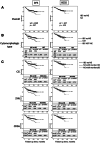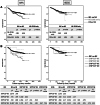The Clinical Significance of Neuroendocrine Features in Invasive Breast Carcinomas
- PMID: 32472950
- PMCID: PMC7485343
- DOI: 10.1634/theoncologist.2020-0081
The Clinical Significance of Neuroendocrine Features in Invasive Breast Carcinomas
Abstract
The latest World Health Organization (WHO) classification categorized invasive breast carcinomas (IBCs) with neuroendocrine (NE) differentiations into neuroendocrine neoplasms (including well-differentiated neuroendocrine tumor [NET] and poorly differentiated neuroendocrine carcinoma [NEC]) and IBC no special type with NE features (IBC-NST-NE). However, little is documented of the clinical significance of this classification; also the precise thresholds and choices of NE markers were variable. In the current study, a large cohort of patients with IBC with NE differentiation were morphologically classified based on the WHO criteria and the clinical relevance of expression of different NE markers (synaptophysin [SYN], chromogranin [CG], and CD56) was evaluated. Among 1,372 IBCs, 52 NET (3.8%) and 172 IBC-NST-NE (12.5%) were identified. Compared with the IBC-no NE cases, NET and IBC-NST-NE were similarly associated with positive estrogen receptor (ER) expression and lower grade (p < .001). For patient outcome, IBC-NST-NE, but not NET, demonstrated significantly worse survival than the IBC-no NE cases. Based on high (≥50%) and low (<50%) expression for each NE marker, independent poor disease-free survival for SYNlo CGlo and SYNhi CGlo cancers (IBC-no NE cases as references, hazard ratio [HR], ≤1.429; p ≤ .026) was found. Interestingly, SYN and CG expression correlated with each other and they shared similar clinicopathologic characteristics; but not with with CD56. In addition, CD56-only positive cases were associated with hormone receptors negativity and basal markers positivity (p ≤ .019), and patients' outcome was similar to IBC-no NE cancers. Our findings suggested that NE markers expression may provide information to fine tune treatment strategy. The relevance of CD56 as NE marker requires further studies. IMPLICATIONS FOR PRACTICE: Invasive breast carcinomas (IBCs) with neuroendocrine (NE) differentiation are heterogeneous in clinicopathologic parameters, biomarker expression, and prognosis. However, there are no specific therapies targeting NE differentiation, and all carcinomas with any NE differentiation are treated similarly as other IBCs. The results of this study suggest that stratification based on NE marker expression levels may provide added prognostically pertinent information, aiding better treatment strategy. In addition, CD56-only positive carcinomas showed a different clinicopathologic and biomarker expression profile compared with those with chromogranin and synaptophysin expression. Relevance of CD56 as an NE marker requires further studies.
Keywords: Breast cancer; CD56; Chromogranin; Neuroendocrine differentiation; Synpatophysin.
© AlphaMed Press 2020.
Conflict of interest statement
Figures



Similar articles
-
Breast cancer with neuroendocrine differentiation: an update based on the latest WHO classification.Mod Pathol. 2021 Jun;34(6):1062-1073. doi: 10.1038/s41379-021-00736-7. Epub 2021 Feb 2. Mod Pathol. 2021. PMID: 33531618 Review.
-
INSM1 is a novel prognostic neuroendocrine marker for luminal B breast cancer.Pathology. 2021 Feb;53(2):170-178. doi: 10.1016/j.pathol.2020.07.004. Epub 2020 Sep 17. Pathology. 2021. PMID: 32951906
-
Comprehensive analysis of clinicopathologic features and p53 mutation in neuroendocrine neoplasms of the breast: experience from a large academic center.Breast Cancer Res Treat. 2022 Dec;196(3):463-469. doi: 10.1007/s10549-022-06766-2. Epub 2022 Oct 19. Breast Cancer Res Treat. 2022. PMID: 36260193
-
Expression of neuroendocrine markers in non-neuroendocrine endometrial carcinomas.Pathology. 2019 Jun;51(4):369-374. doi: 10.1016/j.pathol.2019.02.003. Epub 2019 Apr 27. Pathology. 2019. PMID: 31040050
-
[Clinicopathologic features of primary renal neuroendocrine carcinoma].Zhonghua Bing Li Xue Za Zhi. 2018 Nov 8;47(11):851-856. doi: 10.3760/cma.j.issn.0529-5807.2018.11.007. Zhonghua Bing Li Xue Za Zhi. 2018. PMID: 30423609 Review. Chinese.
Cited by
-
Defining triple-negative breast cancer with neuroendocrine differentiation (TNBC-NED).J Pathol Clin Res. 2023 Jul;9(4):313-321. doi: 10.1002/cjp2.318. Epub 2023 Apr 20. J Pathol Clin Res. 2023. PMID: 37082801 Free PMC article.
-
Metaplastic breast carcinoma producing prominent basal lamina with neuroendocrine differentiation: A case report.Mol Clin Oncol. 2023 Mar 10;18(5):36. doi: 10.3892/mco.2023.2632. eCollection 2023 May. Mol Clin Oncol. 2023. PMID: 37020506 Free PMC article.
-
[Neuroendocrine expression markers in triple-negative, luminal-A, luminal-B and HER2neu breast cancer].Rev Med Inst Mex Seguro Soc. 2024 Jan 8;62(1):1-7. doi: 10.5281/zenodo.10278131. Rev Med Inst Mex Seguro Soc. 2024. PMID: 39110839 Free PMC article. Spanish.
-
Primary Neuroendocrine Tumor of the Breast: Current Understanding and Future Perspectives.Front Oncol. 2022 May 25;12:848485. doi: 10.3389/fonc.2022.848485. eCollection 2022. Front Oncol. 2022. PMID: 35692784 Free PMC article. Review.
-
Breast cancer with neuroendocrine differentiation: an update based on the latest WHO classification.Mod Pathol. 2021 Jun;34(6):1062-1073. doi: 10.1038/s41379-021-00736-7. Epub 2021 Feb 2. Mod Pathol. 2021. PMID: 33531618 Review.
References
-
- World Health Organization . WHO classification of tumours of the Breast. 5th ed. Lyon: IARC; 2019.
-
- Kwon SY, Bae YK, Gu MJ et al. Neuroendocrine differentiation correlates with hormone receptor expression and decreased survival in patients with invasive breast carcinoma. Histopathology 2014;64:647–659. - PubMed
-
- Makretsov N, Gilks CB, Coldman AJ et al. Tissue microarray analysis of neuroendocrine differentiation and its prognostic significance in breast cancer. Hum Pathol 2003;34:1001–1008. - PubMed
MeSH terms
Substances
LinkOut - more resources
Full Text Sources
Medical
Research Materials
Miscellaneous

